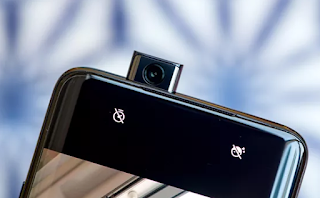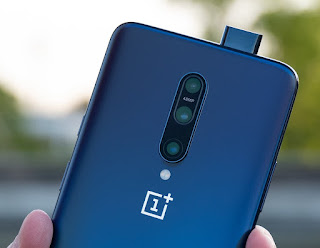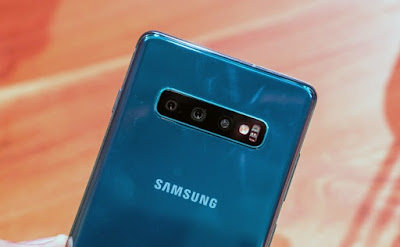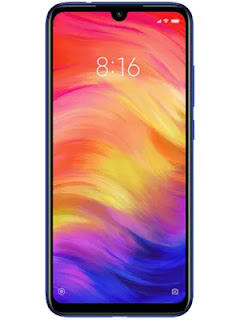A full-screen beauty with pop up camera.
By Jasmeet Singh Khurana
The amazing OnePlus 7 Pro is pretty much the phone of every techie’s dream. It’s an incredible all-screen smartphone that doesn’t ruin its edge-to-edge display neither with a notch or hole punch front-facing camera—Oneplus has opted to roll out the 7 Pro to a pop-up module instead. Undoubtedly, other phones like the Vivo Nex, Nubia X and Oppo Find X have pulled off the pop-up camera and all-screen more before, but none of these have had the software or specs to match up with the best flagship smartphones currently on the market shelves. OnePlus is definitely going to beat the market of flagship smartphones from renowned Brands with the 7 Pro offering an absurd 12GB of ram memory and 256GB of storage. The fantastic set of cameras and a day-and-a-half long battery life is just the cherry on the cake, making this, one of the best value smartphones anyone can buy right now.
In terms of design, the OnePlus 7 Pro has made quite a high improvement over its predecessor the OnePlus 6T. Most notably, this new handset features a larger and complete 6.67-inch full-screen display with curved sides which imitates the Samsung Galaxy S10.Additionally, the new Fluid AMOLED display, which introduces a resolution bump, inclining up from the OnePlus 6T’s 1,080 x 2,340 panel to a 1,440 x 3,120 screen, and that puts it well on with even the 6.4-inch Samsung Galaxy S10 Plus which has 1,440 x 3,040 display.The 7 Pro’s display is a sharp deviation from the previous 6T’s, which featured a 6.41-inch flat face screen and a tiny dew drop notch to make room for a front-facing camera. This new smartphone is strictly an all-screen phone, so you won’t find a notch or any hole punch on the front of this phone, and to make this possible, OnePlus has moved the 7 Pro’s front-facing camera to a motorized pop-up node found at the top left of the phone.
The front-facing camera module extends and retracts in a mere second and it can quickly recognize face to unlock the device. This amazing pop-up module also employs some very clever and smart tricks to ensure that it doesn’t break, such as, immediately retracting itself, once it senses itself falling. This retracting pop up camera also acts as a 16MP selfie camera. It’s Unfortunate to mention that the moving camera module also prevents this phone from being entirely waterproof though, it is somewhat splash proof—so don’t even plan to take a shower with it, as you can do with other smartphones on the market shelves with IPS rating.
At the back, there’s the OnePlus 7 Pro’s triple camera set-up, that includes a 48MP main camera, 8MP telephoto shooter, and 16MP ultra-wide.
As in case of 6T, the company’s previous flagship handset, the 7 Pro also features a glass back with an intricate number of layers to provide it an opalescent, metallic shine, but it’s sad to share that it doesn’t support wireless charging due to the focus on the wired fast charging (warp charger).
Now, returning to the device, it is worth mentioning that the Oneplus 7 Pro doesn't have a visible fingerprint sensor and that’s because it employs an ‘in-display’ fingerprint sensor.
Unfortunately, the in-display fingerprint sensor on this and all other similar devices that have featured one so far—is still too inaccurate, and we found using Face Unlock more reliable and fast.
Powered with the same Qualcomm Snapdragon 855 chip found in many latest flagship Android smartphones, the OnePlus 7 Pro is a nippy performer. The OxygenOS-flavored version of Android 9(Pie) glides smoothly on the 7 Pro with all the apps launching instantly. The OnePlus 7 Pro’s display runs at 90 frames per second by default and that makes scrolling and practically doing anything on the phone feels incredibly smooth.
Speaking of the display, the 6.67 inch all-screen experience is quite amazing. The Wide-screen 21:9 movies nearly fill up the entire screen and reading news stories feels like using a tall Kindle, and during gaming, the visuals expand across the phone’s whole visual canvas. The OnePlus 7 Pro’s dual stereo speakers are the clearest and loudest from any smartphone, and that’s with only one of the duo being front facing, as the bottom speaker is pointed out to the lower right side.
In spite of the fact that, it isn’t marketed as a gaming phone as the Asus Razer Phone 2 or ROG Phone, the OnePlus 7 Pro has an enhanced gaming mode, and that can be activated manually in the phone settings, and this specific mode is designed to block notifications, typically enhance haptic feedback, and activate a faux-HDR mode which brightens highlights and deepens the blacks.
The photography on the OnePlus 7 Pro is consistently impressive and outstanding than most smartphones in the similar price segment. Its main 48MP camera shoots stunningly sharp and amazingly detailed images. And it can also be used to shoot high-resolution, stabilized 4K video as well.
The 16MP ultra-wide shooter works upto-the-mark for capturing large scenes with a slightly more dramatic fish-bowled effect.
The 8MP telephoto shooter gives you a surprising amount of reach by emulating the 78mm focal length of a full-frame digital camera, and the photographs clicked are good but don't expect a DSLR quality images.
Night Sight, Night Mode or low-light shooting modes have become an increasingly common feature on smartphones. The OnePlus’ version is named as Nightscape and as it comes across as the most impressive, but sometimes a frustrating implementation of low-light shooting on phones, till date.
Determining by the Nightscape shots of the OnePlus 7 Pro, the smartphone seems to have taken genuine long exposure and then balances the exposure to look like a high-dynamic range shot. The OnePlus 7 Pro captures a more true-to-life images, better than the Huawei P30 Pro which has some big problems with capturing too much light coming off the billboards as a bloom effect.
Considering that the 7 Pro’s main camera has built-in optical image stabilization, hopefully, a future software update will be able to improve the Night Mode shooting more specifically.
And in any case, if you happen to drain the OnePlus 7 Pro’s battery completely, getting it back to 50% charge, just takes 20 minutes of charging when using its bundled Warp Charger brick.
The Verdict
The OnePlus 7 Pro with it’s incredible specs and joyous all-screen experience, is an exceptional smartphone that puts current flagship phones to shame. The incredible battery life also sets the smartphone as it lasts well more than a day. Though,this phone doesn’t have every modern creature comfort, such as wireless charging and complete waterproofing and this is the smartphone that offers much more value than other flagship smartphones on the market shelves, thanks to its lower price and greater specifications.
By Jasmeet Singh Khurana
The amazing OnePlus 7 Pro is pretty much the phone of every techie’s dream. It’s an incredible all-screen smartphone that doesn’t ruin its edge-to-edge display neither with a notch or hole punch front-facing camera—Oneplus has opted to roll out the 7 Pro to a pop-up module instead. Undoubtedly, other phones like the Vivo Nex, Nubia X and Oppo Find X have pulled off the pop-up camera and all-screen more before, but none of these have had the software or specs to match up with the best flagship smartphones currently on the market shelves. OnePlus is definitely going to beat the market of flagship smartphones from renowned Brands with the 7 Pro offering an absurd 12GB of ram memory and 256GB of storage. The fantastic set of cameras and a day-and-a-half long battery life is just the cherry on the cake, making this, one of the best value smartphones anyone can buy right now.
OnePlus 7 Pro – Design and Features
In terms of design, the OnePlus 7 Pro has made quite a high improvement over its predecessor the OnePlus 6T. Most notably, this new handset features a larger and complete 6.67-inch full-screen display with curved sides which imitates the Samsung Galaxy S10.Additionally, the new Fluid AMOLED display, which introduces a resolution bump, inclining up from the OnePlus 6T’s 1,080 x 2,340 panel to a 1,440 x 3,120 screen, and that puts it well on with even the 6.4-inch Samsung Galaxy S10 Plus which has 1,440 x 3,040 display.The 7 Pro’s display is a sharp deviation from the previous 6T’s, which featured a 6.41-inch flat face screen and a tiny dew drop notch to make room for a front-facing camera. This new smartphone is strictly an all-screen phone, so you won’t find a notch or any hole punch on the front of this phone, and to make this possible, OnePlus has moved the 7 Pro’s front-facing camera to a motorized pop-up node found at the top left of the phone.
The front-facing camera module extends and retracts in a mere second and it can quickly recognize face to unlock the device. This amazing pop-up module also employs some very clever and smart tricks to ensure that it doesn’t break, such as, immediately retracting itself, once it senses itself falling. This retracting pop up camera also acts as a 16MP selfie camera. It’s Unfortunate to mention that the moving camera module also prevents this phone from being entirely waterproof though, it is somewhat splash proof—so don’t even plan to take a shower with it, as you can do with other smartphones on the market shelves with IPS rating.
At the back, there’s the OnePlus 7 Pro’s triple camera set-up, that includes a 48MP main camera, 8MP telephoto shooter, and 16MP ultra-wide.
As in case of 6T, the company’s previous flagship handset, the 7 Pro also features a glass back with an intricate number of layers to provide it an opalescent, metallic shine, but it’s sad to share that it doesn’t support wireless charging due to the focus on the wired fast charging (warp charger).
Now, returning to the device, it is worth mentioning that the Oneplus 7 Pro doesn't have a visible fingerprint sensor and that’s because it employs an ‘in-display’ fingerprint sensor.
Unfortunately, the in-display fingerprint sensor on this and all other similar devices that have featured one so far—is still too inaccurate, and we found using Face Unlock more reliable and fast.
OnePlus 7 Pro – Performance and Gaming
Speaking of the display, the 6.67 inch all-screen experience is quite amazing. The Wide-screen 21:9 movies nearly fill up the entire screen and reading news stories feels like using a tall Kindle, and during gaming, the visuals expand across the phone’s whole visual canvas. The OnePlus 7 Pro’s dual stereo speakers are the clearest and loudest from any smartphone, and that’s with only one of the duo being front facing, as the bottom speaker is pointed out to the lower right side.
In spite of the fact that, it isn’t marketed as a gaming phone as the Asus Razer Phone 2 or ROG Phone, the OnePlus 7 Pro has an enhanced gaming mode, and that can be activated manually in the phone settings, and this specific mode is designed to block notifications, typically enhance haptic feedback, and activate a faux-HDR mode which brightens highlights and deepens the blacks.
The OnePlus 7 Pro – Camera
The 16MP ultra-wide shooter works upto-the-mark for capturing large scenes with a slightly more dramatic fish-bowled effect.
The 8MP telephoto shooter gives you a surprising amount of reach by emulating the 78mm focal length of a full-frame digital camera, and the photographs clicked are good but don't expect a DSLR quality images.
Night Sight, Night Mode or low-light shooting modes have become an increasingly common feature on smartphones. The OnePlus’ version is named as Nightscape and as it comes across as the most impressive, but sometimes a frustrating implementation of low-light shooting on phones, till date.
Determining by the Nightscape shots of the OnePlus 7 Pro, the smartphone seems to have taken genuine long exposure and then balances the exposure to look like a high-dynamic range shot. The OnePlus 7 Pro captures a more true-to-life images, better than the Huawei P30 Pro which has some big problems with capturing too much light coming off the billboards as a bloom effect.
Considering that the 7 Pro’s main camera has built-in optical image stabilization, hopefully, a future software update will be able to improve the Night Mode shooting more specifically.
OnePlus 7 Pro – Battery Life
At the end of most of the testing days with the OnePlus 7 Pro, the smartphone still used to retain 40% of its remaining battery life, and that even after a full day of heavy usage.This is worth mentioning that this phone that can last you a day and a half, even if you are from a heavy user segment.And in any case, if you happen to drain the OnePlus 7 Pro’s battery completely, getting it back to 50% charge, just takes 20 minutes of charging when using its bundled Warp Charger brick.
The Verdict
The OnePlus 7 Pro with it’s incredible specs and joyous all-screen experience, is an exceptional smartphone that puts current flagship phones to shame. The incredible battery life also sets the smartphone as it lasts well more than a day. Though,this phone doesn’t have every modern creature comfort, such as wireless charging and complete waterproofing and this is the smartphone that offers much more value than other flagship smartphones on the market shelves, thanks to its lower price and greater specifications.





















